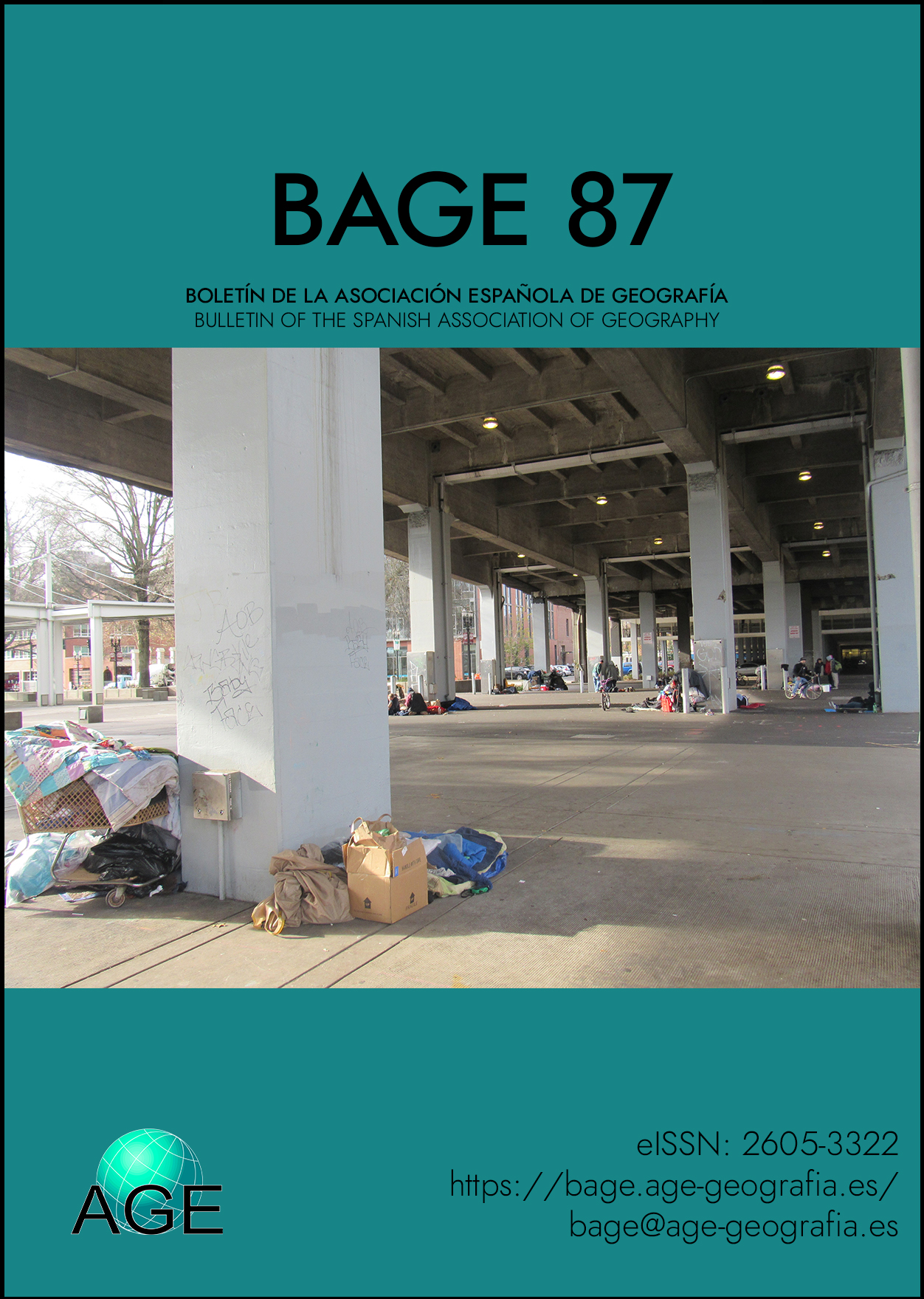Rethinking the politics of vulnerability: neighborhood empowerment in Kansas City Missouri (USA)
Contenido principal del artículo
Resumen
Repensar la política de vulnerabilidad urbana: el empoderamiento de los barrios en Kansas City Missouri (EE. UU.)
El artículo demuestra la racialización de los barrios urbanos en Kansas City-Missouri, EE. UU., y las formas en las que las asociaciones de voluntarios de ciudadanos trabajan para resistir y reducir las condiciones de vulnerabilidad. El artículo presenta datos de modelos históricos de prácticas inmobiliarias con prejuicios raciales, incluido el redlining, y demuestra cómo estos patrones continúan dando forma a las políticas de vulnerabilidad en la región en la actualidad. Tres tipos de barrios urbanos proporcionan evidencias de las formas en las que las asociaciones de vecinos se organizan para responder a las condiciones de vulnerabilidad social y espacial. En contraste con las estimaciones de baja resiliencia comunitaria en estos barrios, el autor demuestra que el empoderamiento es un contrapunto importante a las vulnerabilidades concentradas.
Detalles del artículo
Número
Sección

Esta obra está bajo una licencia internacional Creative Commons Atribución-NoComercial 4.0.
Cómo citar
Referencias
Aguirre, B. (2007). Dialectics of vulnerability and resilience. Georgetown Journal on Poverty Law and Policy, 14(1), 39-60. Retrieved from https://heinonline.org/HOL/P?h=hein.journals/geojpovlp14&i=41
Anguelovski, I. (2014). Neighborhood as Refuge: Community Reconstruction, Place Remaking and Environmental Justice in the City. Cambridge, MA: The MIT Press.
Benner, C., & Pastor, M. (2012). Just Growth: Inclusion and Prosperity in America’s Metropolitan Regions. Oxfordshire: Routledge.
Betancur, J., & J. Smith. (2016). Claiming Neighborhood: New ways of understanding urban change. Chicago: University of Illinois Press.
Burgess, E. (1925). The Growth of the City: An introduction to the Research Project. In R. Park, E. Burgess & R. D. McKenzie (Eds.), The City (pp. 47-62). Chicago: University of Chicago Press.
Cortright, J., & D. Mahmoudi (2014). Lost in Place: Why the persistence and spread of concentrated poverty – not gentrification – is our biggest urban challenge. City Observatory. Retrieved from https://cityobservatory.org/wp-content/uploads/2014/12/LostinPlace_12.4.pdf
Drake, St. C., & Cayton, H. R. (1945). Black Metropolis: A Study of Negro Life in a Northern City. New York: Harcourt, Brace and Co.
DuBois, W.E.B. (1899). The Philadelphia Negro: A Social Study. Philadelphia: The University of Pennyslvania Press.
Fullilove, M. T. (2020). Main Street: How a City’s Heart Connects Us All. New York: New Village Press.
Gallopín G. (2006). Linkages between vulnerability, resilience and adaptive capacity. Global Environmental Change, 16, 293-303.
Garcia-Hallett, J., Like, T., Torres, T., & Irazábal, C. (2020). Latinxs in the Kansas City Metro Area: Policing and Criminalization in Ethnic Enclaves. Journal of Planning Education and Research, 40(2), 151-168. https://doi.org/10.1177/0739456X19882749
Gotham, K. F. (2002a). Race, real estate, and uneven development: The Kansas City experience, 1900-2000. Albany: State University of New York Press.
Gotham, K. F. (2002b). Beyond Invasion and Succession: School Segregation, Real Estate Blockbusting, and the Political Economy of Neighborhood Racial Transition. City & Community, 1(1), 83–111. https://doi.org/10.1111/1540-6040.00009
Gotham, K. F., & R. Campanella. (2011). Coupled vulnerability and resilience: the dynamics of cross-scale interactions in post-Katrina New Orleans. Ecology and Society, 16(3), 12. http://dx.doi.org/10.5751/ES-04292-160312
Hoyt, H. (1939). The Structure and Growth of Residential Neighborhoods in American Cities. Washington DC, US Government Printing Office.
Irazábal, C., & J. Neville (2007). Neighborhoods in the Lead: Grassroots planning for social transformation in post-Katrina New Orleans? Planning Practice & Research, 22(2), 131-153. https://doi.org/10.1080/02697450701584329
Jacobs, J. (1961). The Uses of City Neighborhoods, In The Death and Life of Great American Cities (pp. 112-140). New York: Random House.
Kansas City (Mo.), City Plan Commission (1947). The master plan for Kansas City. Kansas City. Retrieved from https://catalog.hathitrust.org/Record/000649525
Kretzmann, J., & J. L. McKnight. (1993). Building Communities from the Inside Out: A Path Toward Finding and Mobilizing a Community's Assets. Evanston, IL: Institute for Policy Research.
Massey, D. S., & Denton, N. A. (1993). American Apartheid: Segregation and the making of the underclass. Cambridge, Mass.: Harvard University Press.
Nelson, R. K., Winling, L., Marciano, R., Connolly, N., et al. (n.d.). Mapping Inequality. In American Panorama. Retrieved from https://dsl.richmond.edu/panorama/redlining
Pader, E.-J. (1994). Spatial Relations and Housing Policy: Regulations that Discriminate Against Mexican-origin Households. Journal of Planning Education and Research, 13(2), 119–135. https://doi.org/10.1177/0739456X9401300204
Perry, C. (1929). The Neighborhood Unit. In Regional Plan of New York and its Environs. New York: Regional Plan of New York and Its Environs.
Robert Woods Johnson Foundation (2015). Kansas City MO: Culture of Health Prize Winner. In Robert Woods Johnson Foundation. Retrieved from https://www.rwjf.org/en/library/articles-and-news/2015/10/coh-prize-kansascity-mo-story.html
Rollinson, P. (1998). The Everyday Geography of the Homeless in Kansas City. Geografiska Annaler. Series B, Human Geography, 80(2), 101-115.
Thomas, J. M. (1998). Racial Inequality and Empowerment: Necessary Theoretical Constructs for Understanding U.S. Planning History. In L. Sandercock (Ed.), Making the Invisible Visible: A Multicultural Planning History (pp. 198-208). Berkeley: University of California Press.
United States Census Bureau (2018). American Community Survey (2014-2018, 5-year estimates). Retrieved from https://www.census.gov/programs-surveys/acs/technical-documentation/table-and-geography-changes/2018/5-year.html
United States Census Bureau (2020). Community Resilience Estimates. Retrieved from https://www.census.gov/data/experimental-data-products/community-resilience-estimates.html
Vey, J. S. (2006). Organizing for Success: A Call to Action for the Kansas City Region. In The Brookings Institution. Metropolitan Policy Program.Research Brief.
Weichselgartner, J., & Kelman, I. (2015). Geographies of resilience: Challenges and opportunities of a descriptive concept. Progress in Human Geography, 39(3), 249-267. https://doi.org/10.1177/0309132513518834
Woods, C. A. (1998). Development arrested: The blues and plantation power in the Mississippi Delta. London: Verso.
Young, I. M. (1990). Justice and the politics of difference. Princeton, N.J: Princeton University Press.





